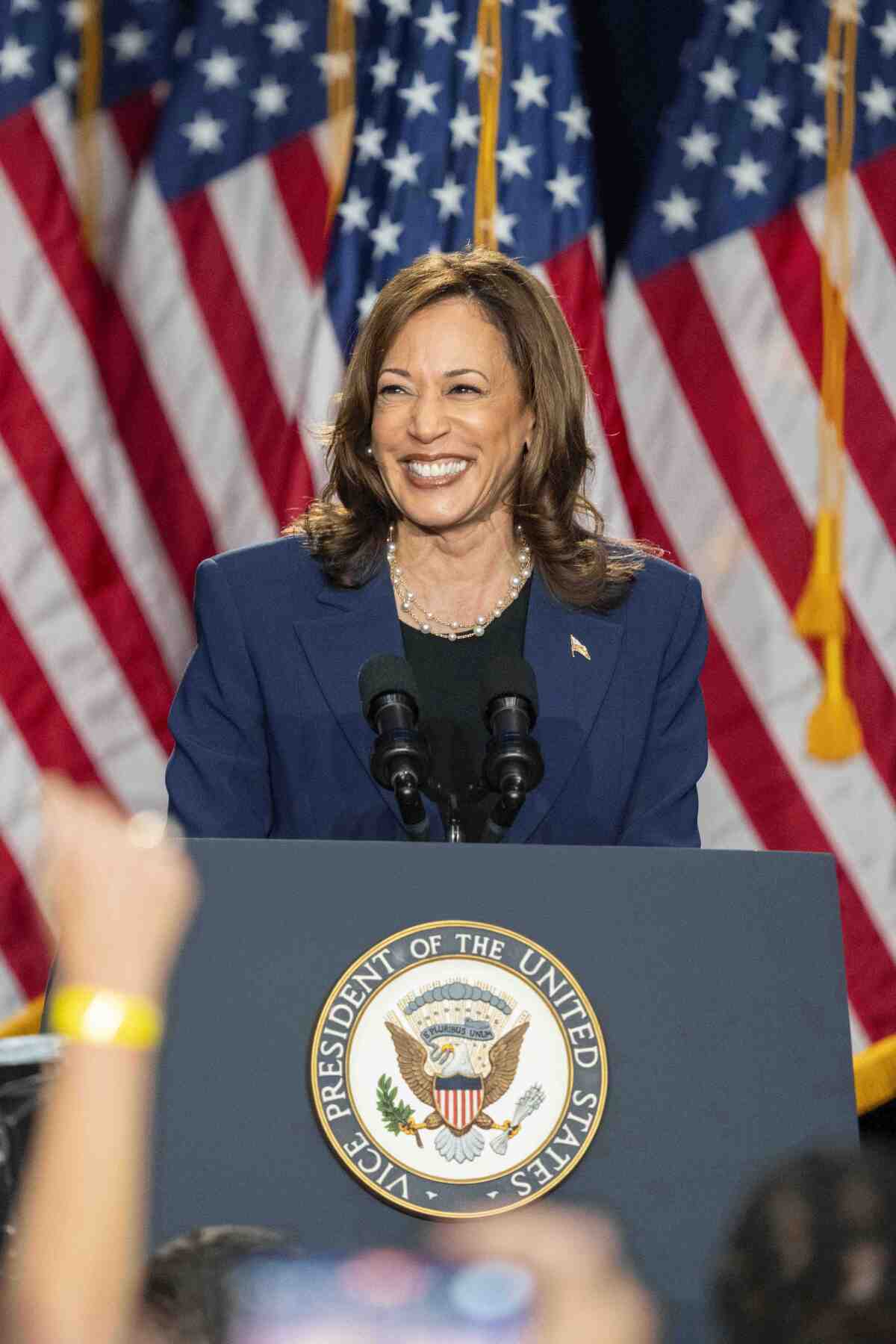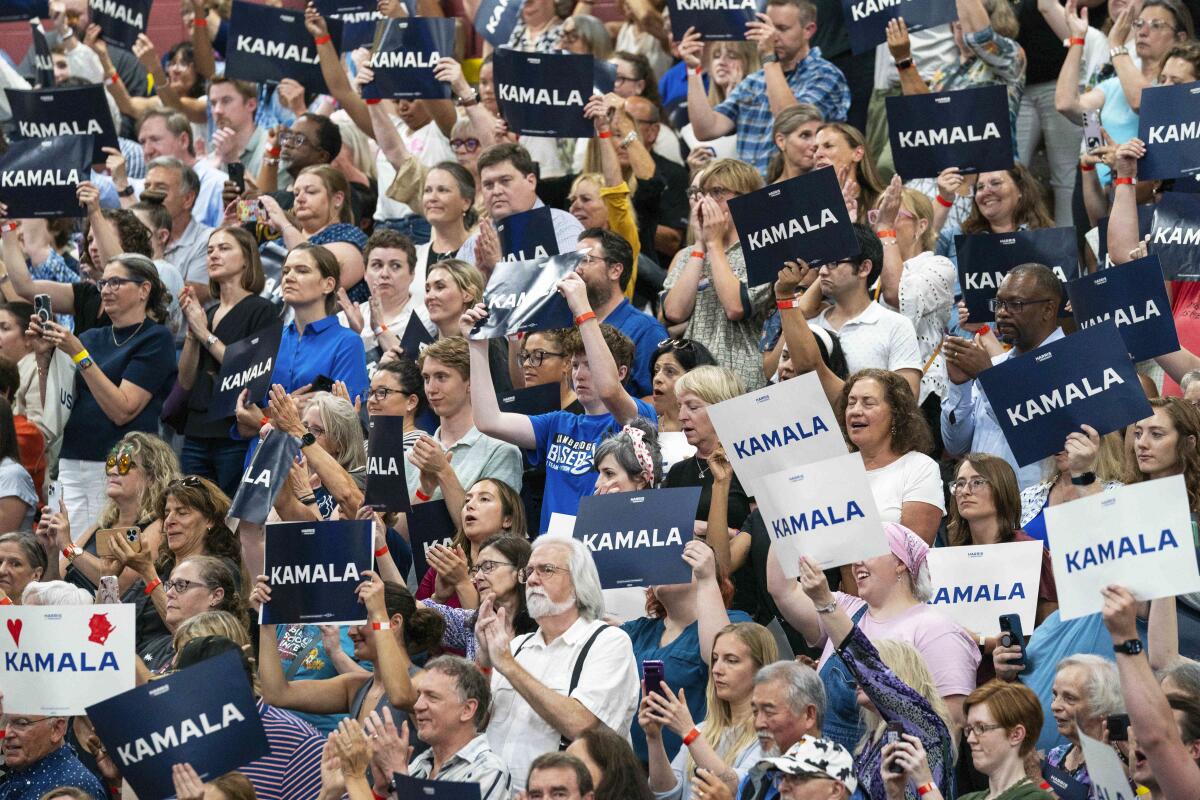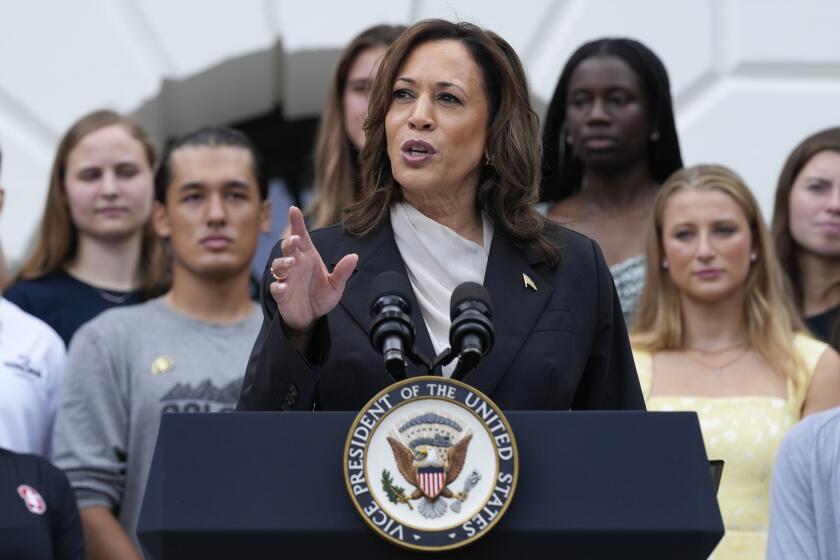Column: Kamala Harris is still the underdog against Trump. These three things could change that

WASHINGTON — Almost everything has gone right for Vice President Kamala Harris in the initial days of her sudden presidential campaign — rapid consolidation of support from party officials, a massive surge in financial contributions and a burst of enthusiasm among party activists that has swept aside the despair that had enveloped many Democrats.
Yet Harris remains the underdog in the race against former President Trump, at least in terms of winning the states needed for an electoral college majority.
Whether that changes could turn on three fundamental strategic decisions Harris and her top advisors must make in the 3½ weeks between now and the opening of the Democratic National Convention on Aug. 19.
In rapid succession, Harris must:
— Settle on an electoral college path, which will guide how the campaign spends its money and, critically, its limited time;
— Choose a running mate, which will help set a tone for the campaign and, if possible, reinforce the electoral strategy; and
— Perhaps most important, decide how she wants to position herself politically to rebut the Republican portrayal of her as a feckless, out-of-touch California liberal.
Typically, campaigns spend weeks — sometimes months — studying reams of data to make those decisions. Harris has just days.
You're reading the L.A. Times Politics newsletter
Anita Chabria and David Lauter bring insights into legislation, politics and policy from California and beyond. In your inbox three times per week.
You may occasionally receive promotional content from the Los Angeles Times.
Moreover, Harris and her team will have to make their choices more by gut instinct than is usual: Polling data so far provide tantalizing hints about the status of the race, but with the presidential campaign traversing territory that is without precedent in American politics, both sides, and outside analysts, are flying somewhat blind.
“It’s still really early” to accurately measure what the public thinks about the remade Democratic ticket, said Democratic pollster Natalie Jackson. “All of this is still sinking in with the general public.”
With major news events coming, including the selection of a running mate and the Democratic convention, “it may take awhile,” perhaps until Labor Day, to get a really clear read, she said.
The electoral map
Harris has a few major advantages to work with, most importantly the abiding loathing that a huge swath of voters has for her opponent.

Even when President Biden quit the race Sunday, Trump was leading by only a few points nationwide. That was true despite the fact that only about 1 in 5 voters thought Biden was mentally up to the job. A Reuters-Ipsos poll taken just after the decision put the number at 22%.
Trump’s inability to post a larger lead in such circumstances provides a stark measure of the resistance the former president inspires.
Joe Biden will be remembered as an ambitious, successful president who waited many years to win the White House, then waited too long to leave his last race.
Because of that, Harris doesn’t need to make up massive ground. In these highly polarized political times, however, even small shifts require massive effort.
Where to focus that effort will be Harris’ first key decision.
Winning the presidency requires carrying enough states to rack up 270 electoral votes. A Democrat can count on a base of 226 to start. Biden’s decline threatened to put some of those states at risk, but his decision to withdraw probably restored the map to its normal configuration.
Getting from 226 to 270 requires a Democrat to win some combination of the six swing states — Nevada and Arizona in the West; Wisconsin, Michigan and Pennsylvania in the industrial North; and Georgia in the Southeast. Democrats have perennially hoped to add a seventh state, North Carolina, to that list, but in the last 60 years have carried it only twice — in 1976 with Jimmy Carter and 2008 with Barack Obama.
The Republican convention’s lesson was that there is no New Trump — only one committed to cementing the MAGA transformation of the GOP for generations.
Biden carried all six swing states in 2020, but even before his disastrous debate with Trump in June, polls suggested he had seemed to fall out of contention in the three battlegrounds in the Southeast and the West, largely because of diminished support among Latino and Black voters.
That left his campaign with a single path to winning: carrying all three Northern industrial states, which have significantly whiter electorates than their Southern counterparts. Sweeping the three plus the Democratic base states would deliver precisely 270 votes.

Potential advantage among Latino voters
Early polling suggests Harris may have more options.
She is positioned for significant gains among Latino voters who were “disaffected” and inclined to sit out a Trump-Biden election, said Carlos Odio of Equis Research, which focuses on Latino voters and has analyzed Trump’s gains among them in 2020.
In the days leading up to Biden’s decision to withdraw, the firm polled Latino voters in Nevada and found Harris performing significantly stronger than Biden, especially among women younger than 40.
“A lot of people were checked out of the election, didn’t like their choices,” Odio said. But, he added, those voters don’t like Trump and were “looking for an alternative.”
“She can be that alternative.”
Similarly, Civiqs, an Oakland-based firm allied with Democrats, began tracking a potential Harris-Trump race two weeks before Biden dropped out, running the survey in parallel with their Biden-Trump daily track.
“There was a large reservoir of voters who were telling us they were undecided or third-party voters” in a Biden-Trump race, said the firm’s director, Drew Linzer. In a Harris-Trump race, “they move.”
The movement is especially pronounced among voters younger than 35 and among Black and Latino voters, he said. For example, among voters ages 18 to 34, Biden led by fewer than 10 percentage points, while Harris led by 20, the firm found.
Linzer and Odio stressed that any polling data so far have to be considered highly preliminary. The numbers, however, point to what Democrats hope Harris can achieve.
“This resets the campaign back to 2020,” when “Democrats were competitive in every battleground state,” said John Della Volpe of Harvard’s Institute of Politics, who specializes in surveying young voters and polled for Biden in the last election. In addition to the polling, he noted the outpouring of money and the rapid proliferation of pro-Harris memes and messages on social media.
“Even before the debate, it felt like there was a narrowing of the pathway to 270,” Della Volpe said. “Now, the pathways are starting to expand.”
The California delegation, the largest in the Democratic Party, unanimously voted to back Harris Monday evening, all but guaranteeing her nomination.
The running mate choice
If Harris can sustain gains among Latino voters, Nevada and Arizona would once again become highly competitive. Gains among Black voters could put Georgia back in play — at least one public poll released this week showed Harris only 1 point behind Trump in the state, although the small size of the survey made its results questionable.
Such gains would take some of the pressure off Democrats to sweep the three northern swing states, although Pennsylvania, the largest, with 19 electoral votes, remains hard to replace in a realistic Democratic scenario.
The choice of a running mate “could be a signal of where they’re headed with the map,” Jackson said.
The candidates known to be under consideration are all similar in several ways — white, male, moderate governors or senators. But they could differ in their impact on key states.
If Arizona and Nevada seem winnable, that would strengthen the case for Arizona Sen. Mark Kelly, the former astronaut.
George Clooney, Netflix co-founder Reed Hastings and other Hollywood heavyweights, who pressured President Biden to not seek reelection, have rallied behind the campaign of Vice President Kamala Harris.
A play for Georgia could make North Carolina Gov. Roy Cooper, or perhaps Kentucky Gov. Andy Beshear, more attractive.
If sweeping the northern states remains the only realistic path, that would favor Pennsylvania Gov. Josh Shapiro or, perhaps, Minnesota Gov. Tim Walz.
The campaign will have little time to vet the candidates and make a decision: Procedures put forward by the Democratic Party’s Rules Committee call for the ticket to be settled by Aug. 7 in order to meet an early ballot deadline in Ohio.

Defining her image
At the same time, the campaign needs to decide how to retool plans for the convention to showcase Harris, rather than Biden.
That’s taken on greater importance because, unlike Biden, Harris remains partially a blank slate to a large number of voters.
“This race is more fluid now — the Vice President is well known, but less well known than both Trump and President Biden,” campaign manager Jen O’Malley Dillon wrote in an open memo Wednesday. “This shift in the race opens up additional persuadable voters,” she said.
Republicans have moved briskly to try to define her, pushing their equation: Black woman from California equals too liberal — “the same as Biden, but much more radical,” as Trump put it to reporters on a call this week.
The GOP couples that accusation with an effort to tie Harris to what it calls the administration’s failures at the border, a potentially powerful way to connect with perceptions that many voters have of Democrats as weak on public safety.
In her 2020 campaign for the nomination, Harris faced the opposite problem — trying to persuade party activists that she was progressive enough, a challenge that often seemed to tie her in knots.
A key element of her resume — her experience as a prosecutor — turned into a liability with primary voters in the highly charged circumstances after the murder of George Floyd by Minneapolis police.
“Kamala is a cop” became a prominent anti-Harris slogan on the left.
The dynamic is far different now in a general election in which the median voter, especially in the swing states, is significantly more conservative than those who take part in Democratic primaries.
Harris has already featured her law enforcement background as a contrast with Trump’s misconduct, including his conviction on 34 felony counts.
“I took on perpetrators of all kinds. Predators who abused women, fraudsters who ripped off consumers, cheaters who broke the rules for their own gain. So hear me when I say, I know Donald Trump’s type,” she has now said at repeated campaign events.
How much further she goes in talking about her law enforcement background will be a key decision about how to portray herself to voters. Whether the Democrats’ often-vocal left wing attacks her for that — or for other deviations from progressive orthodoxy — will, in turn, be key to whether the party’s newfound unity will persist or wilt in the summer’s heat.
What else to follow:
Poll of the week: Only a quarter of Americans are highly satisfied with the quality of news coverage of local governments and politics.
The weekly must read: A look back at Harris’ roots in San Francisco politics and at Howard University.
The L.A. Times special: California’s news industry is in steep decline. Here’s what is at stake
—
Was this newsletter forwarded to you? Sign up here to get it in your inbox.
Get the L.A. Times Politics newsletter
Deeply reported insights into legislation, politics and policy from Sacramento, Washington and beyond. In your inbox three times per week.
You may occasionally receive promotional content from the Los Angeles Times.








